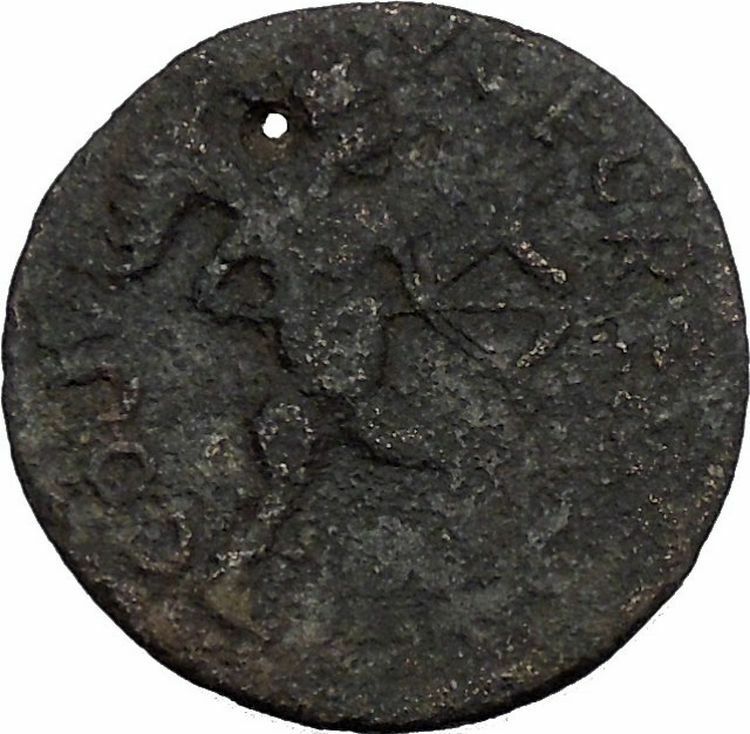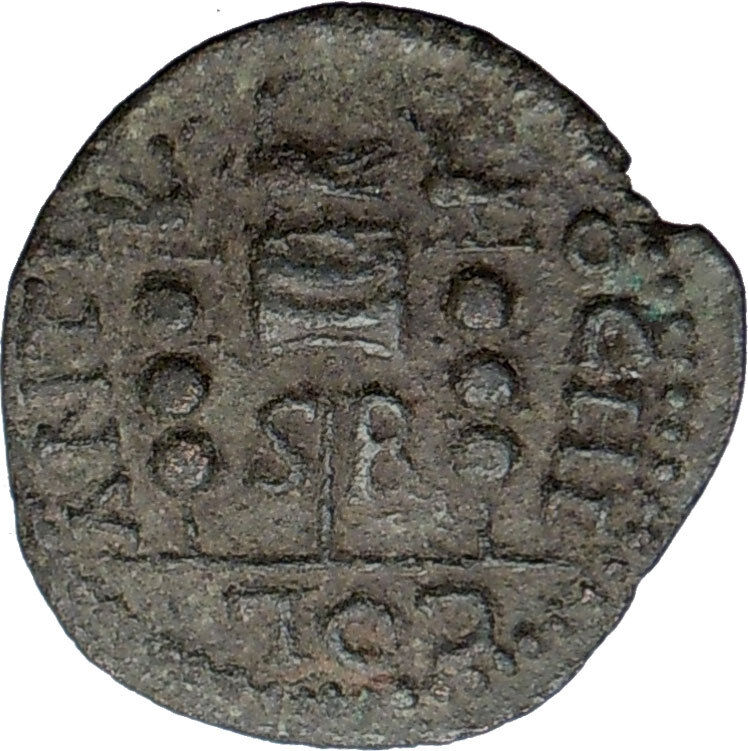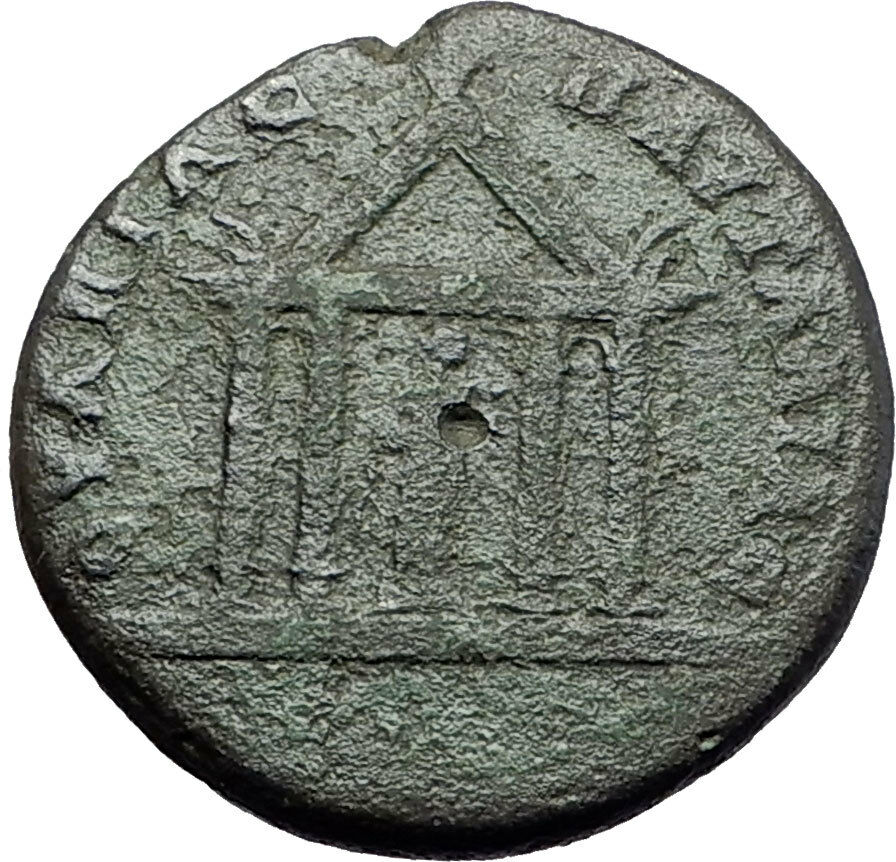|
Greek city of
Irenopolis-Neronias
in
Cilicia Pseudo-Autonomous Issue
Bronze 19mm (8.39 grams) Time of Marcus Aurelius, circa 170-171 A.D.
Reference: Sear GIC 5162; SNG France 2262; SNG Levante 1608; SNG Levante Suppl.
383
Laureate and draped bust of bearded Kronos right, before
ΘΙΡ (= year 119 of the City Era = A.D. 170/1).
IPHNOΠΟΛΙΤΩΝ, Nude Hercules reclining left, holding kantharos; club
below.
Irenopolis or Eirenopolis (Ancient Greek: Εἰρηνόπολις; Greek:
Εἰρηνούπολις) was an ancient and medieval city in northeastern Cilicia not far
from the Calycadnus river, also known briefly as Neronias (Ancient Greek:
Νερωνίας; Greek: Νερωνιάς) in honour of the Roman emperor Nero. Irenopolis was
also an episcopal see that is now included in the Catholic Church’s list of
titular sees.
You are bidding on the exact item pictured,
provided with a Certificate of Authenticity and Lifetime Guarantee of
Authenticity.
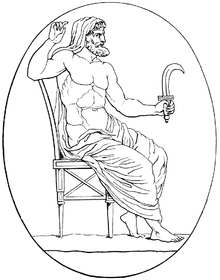
In
Greek mythology
, Cronusor
Kronos (Greek:
Κρόνος, krónos) was the leader and
youngest of the first generation of
Titans
, the divine descendants of
Uranus
, the sky, and
Gaia
, the earth. He overthrew his father and
ruled during the mythological
Golden Age
, until he was overthrown by his own
son Zeus
and imprisoned in
Tartarus
.
Cronus was usually depicted with a
Harpe
,
Scythe
or a
Sickle
, which was the instrument he used to
castrate
and depose
Uranus
, his father. In
Athens
, on the twelfth day of the Attic month
of Hekatombaion
, a festival called
Kronia
was held in honour of Cronus to
celebrate the harvest, suggesting that, as a result of his association with the
virtuous Golden Age, Cronus continued to preside as a patron of
harvest
. Cronus was also identified in
classical antiquity
with the
Roman deity
Saturn
.
Greek
mythology and early myths
In an ancient myth recorded by
Hesiod
‘s
Theogony
, Cronus envied the power of his
father, the ruler of the universe, Uranus. Uranus drew the enmity of Cronus’
mother,
Gaia
, when he hid the gigantic youngest
children of Gaia, the hundred-handed
Hecatonchires
and one-eyed
Cyclopes
, in the
Tartarus
, so that they would not see the light.
Gaia created a great stone sickle
and gathered together
Cronus and his brothers to persuade them to castrate Uranus.
Only Cronus was willing to do the deed, so Gaia gave him the sickle and
placed him in ambush. When Uranus met with Gaia, Cronus attacked him with the
sickle, castrating
him and casting his
testicles
into the sea. From the
blood
that spilled out from Uranus and fell
upon the earth, the
Gigantes
,
Erinyes
, and
Meliae
were produced. The testicles produced a
white foam from which the goddess
Aphrodite
emerged. For this, Uranus threatened
vengeance and called his sons Titenes (Τιτῆνες; according to Hesiod
meaning “straining ones,” the source of the word “titan”, but this etymology is
disputed) for overstepping their boundaries and daring to commit such an act.
(In an alternate version of this myth, a more benevolent Cronus overthrew the
wicked serpentine Titan
Ophion
. In doing so, he released the world from
bondage and for a time ruled it justly.)
Giorgio Vasari
: The Mutilation of
Uranus by Saturn (Cronus)
After dispatching Uranus, Cronus re-imprisoned the
Hecatonchires
, and the
Cyclopes
and set the dragon
Campe
to guard them. He and his sister
Rhea
took the throne of the world as king and
queen. The period in which Cronus ruled was called the
Golden Age
, as the people of the time had no
need for laws or rules; everyone did the right thing, and immorality was absent.
Cronus learned from Gaia and Uranus that he was destined to be overcome by
his own sons, just as he had overthrown his father. As a result, although he
sired the gods Demeter
,
Hestia
,
Hera, Hades
and
Poseidon
by Rhea, he devoured them all as soon
as they were born to prevent the prophecy. When the sixth child,
Zeus, was born Rhea sought Gaia to devise a plan to save them and to
eventually get retribution on Cronus for his acts against his father and
children. (Another child Cronus is reputed to have fathered is
Chiron
, by
Philyra
.)
Painting by
Peter Paul Rubens
of Cronus
devouring one of his children
Rhea secretly gave birth to Zeus in
Crete
, and handed Cronus a stone wrapped in
swaddling clothes, also known as the
Omphalos
Stone, which he promptly swallowed,
thinking that it was his son.
Rhea kept Zeus hidden in a cave on
Mount Ida, Crete
. According to some versions of
the story, he was then raised by a goat named
Amalthea
, while a company of
Kouretes
, armored male dancers, shouted and
clapped their hands to make enough noise to mask the baby’s cries from Cronus.
Other versions of the myth have Zeus raised by the
nymph
Adamanthea
, who hid Zeus by dangling him by a
rope from a tree so that he was suspended between the earth, the sea, and the
sky, all of which were ruled by his father, Cronus. Still other versions of the
tale say that Zeus was raised by his grandmother, Gaia.
Once he had grown up, Zeus used an
emetic
given to him by Gaia to force Cronus to
disgorge the contents of his stomach in reverse order: first the stone, which
was set down at Pytho under the glens of
Mount Parnassus
to be a sign to mortal men, and
then his two brothers and three sisters. In other versions of the tale,
Metis
gave Cronus an emetic to force him to
disgorge the children, or Zeus cut Cronus’ stomach open. After freeing his
siblings, Zeus released the Hecatonchires, and the Cyclopes who forged for him
his thunderbolts, Poseidon’s trident and Hades’ helmet of darkness.
In a vast war called the
Titanomachy
, Zeus and his brothers and sisters,
with the help of the Hecatonchires, and Cyclopes, overthrew Cronus and the other
Titans. Afterwards, many of the Titans were confined in
Tartarus
, however, Atlas, Epimetheus, Menoetius,
Oceanus and Prometheus were not imprisoned following the
Titanomachy
. Gaia bore the monster
Typhon
to claim revenge for the imprisoned
Titans.
Accounts of the fate of Cronus after the Titanomachy differ. In
Homeric
and other texts he is imprisoned with
the other Titans in Tartarus. In Orphic poems, he is imprisoned for eternity in
the cave of Nyx. Pindar describes his release from Tartarus, where he is made
King of Elysium
by Zeus. In another version[citation
needed], the Titans released the Cyclopes from
Tartarus, and Cronus was awarded the kingship among them, beginning a Golden
Age. In Virgil
‘s
Aeneid
[citation
needed], it is
Latium
to which Saturn (Cronus) escapes and
ascends as king and lawgiver, following his defeat by his son Jupiter (Zeus).
One other account referred by
Robert Graves
(who claims to be following the
account of the Byzantine mythographer
Tzetzes
) it is said that Cronus was castrated
by his son Zeus just like he had done with his father Uranus before. However the
subject of a son castrating his own father, or simply castration in general, was
so repudiated by the Greek mythographers of that time that they suppressed it
from their accounts until the Christian era (when Tzetzes wrote).
Hercules is the Roman name for the Greek
divine
hero Heracles
, who was the son of
Zeus (Roman equivalent
Jupiter
) and the mortal
Alcmene
. In
classical mythology
, Hercules is famous for his
strength and for his numerous far-ranging adventures.

The
Romans adapted the Greek hero’s iconography and myths for their literature and
art under the name Hercules. In later
Western art
and literature and in
popular culture
, Hercules is more
commonly used than Heracles as the name of the hero. Hercules was a
multifaceted figure with contradictory characteristics, which enabled later
artists and writers to pick and choose how to represent him. This article
provides an introduction to representations of Hercules in the
later tradition
.
Labors of Hercules
Hercules is known for his many adventures, which took him to the far reaches
of the
Greco-Roman world
. One cycle of these
adventures became
canonical
as the “Twelve Labours,” but the list
has variations. One traditional order of the labours is found in the
Bibliotheca
as follows:
- Slay the
Nemean Lion
.
- Slay the nine-headed
Lernaean Hydra
.
- Capture the
Golden Hind of Artemis
.
- Capture the
Erymanthian Boar
.
- Clean the Augean
stables in a single day.
- Slay the
Stymphalian Birds
.
- Capture the
Cretan Bull
.
- Steal the
Mares of Diomedes
.
- Obtain the girdle of
Hippolyta
, Queen of the
Amazons
.
- Obtain the cattle of the monster
Geryon
.
- Steal the apples of the
Hesperides
.
- Capture and bring back
Cerberus
.
The Latin
name Hercules was borrowed through
Etruscan
, where it is represented variously as
Heracle
, Hercle, and other forms. Hercules was
a favorite subject for
Etruscan art
, and appears often on
bronze mirrors
. The Etruscan form Herceler
derives from the Greek Heracles via
syncope
. A mild oath invoking Hercules (Hercule!
or Mehercle!) was a common
interjection
in
Classical Latin
.

Baby Hercules strangling a
snake
sent to
kill him in his
cradle
(Roman marble, 2nd century CE)
Hercules had a number of
myths
that were distinctly Roman. One of these
is Hercules’ defeat of
Cacus
, who was terrorizing the countryside of
Rome. The hero was associated with the
Aventine Hill
through his son
Aventinus
.
Mark Antony
considered him a personal patron
god, as did the emperor
Commodus
. Hercules received various forms of
religious veneration
, including as a
deity concerned with children and childbirth
,
in part because of myths about his precocious infancy, and in part because he
fathered countless children. Roman brides wore a special belt tied with the “knot
of Hercules“, which was supposed to be hard to untie. The comic
playwright Plautus
presents the myth of Hercules’
conception as a sex comedy in his play
Amphitryon
;
Seneca
wrote the tragedy Hercules Furens
about his bout with madness. During the
Roman Imperial era
, Hercules was worshipped
locally from Hispania
through
Gaul.
Medieval mythography
After the Roman Empire became
Christianized
, mythological narratives were
often reinterpreted as
allegory
, influenced by the philosophy of
late antiquity
. In the 4th century,
Servius
had described Hercules’ return from the
underworld as representing his ability to overcome earthly desires and vices, or
the earth itself as a consumer of bodies. In medieval mythography, Hercules was
one of the heroes seen as a strong role model who demonstrated both valor and
wisdom, with the monsters he battles as moral obstacles. One
glossator
noted that when
Hercules became a constellation
, he showed that
strength was necessary to gain entrance to Heaven.
Medieval mythography was written almost entirely in Latin, and original Greek
texts were little used as sources for Hercules’ myths.
Renaissance
mythography
The Renaissance
and the invention of the
printing press
brought a renewed interest in
and publication of Greek literature. Renaissance mythography drew more
extensively on the Greek tradition of Heracles, typically under the Romanized
name Hercules, or the alternate name
Alcides
. In a chapter of his book
Mythologiae (1567), the influential mythographer
Natale Conti
collected and summarized an
extensive range of myths concerning the birth, adventures, and death of the hero
under his Roman name Hercules. Conti begins his lengthy chapter on Hercules with
an overview description that continues the moralizing impulse of the Middle
Ages:
Hercules, who subdued and destroyed monsters, bandits, and criminals, was
justly famous and renowned for his great courage. His great and glorious
reputation was worldwide, and so firmly entrenched that he’ll always be
remembered. In fact the ancients honored him with his own temples, altars,
ceremonies, and priests. But it was his wisdom and great soul that earned
those honors; noble blood, physical strength, and political power just
aren’t good enough.
_with_Female_Head_-_Walters_482763_-_View_A.jpg/260px-Greek_-_Red-Figure_Kantharos_(Drinking_Vessel)_with_Female_Head_-_Walters_482763_-_View_A.jpg)
A
kantharos or cantharus is a type of
Greek pottery
used for drinking. In its iconic
“Type A” form, it is characterized by its deep bowl, tall pedestal foot, and
pair of high-swung handles which extend above the lip of the pot. The Greek
words kotylos (κότῦλος, masculine) and kotyle (κοτύλη, feminine)
are other ancient names for this same shape.
The kantharos is a cup used to hold
wine, possibly for drinking or for
ritual
use or
offerings
. The kantharos seems to be an
attribute of
Dionysos
, the god of wine, who was associated
with
vegetation
and
fertility
.
It may not be a banquet-cup, but rather a vessel used in pagan cult as a
symbol of
rebirth or resurrection
, the
immortality
offered by wine, “removing in
moments of ecstasy the burden of self-consciousness and elevating man to the
rank of deity.”
|







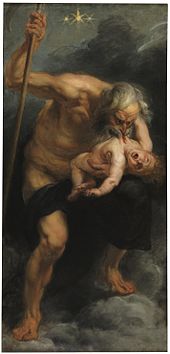


_with_Female_Head_-_Walters_482763_-_View_A.jpg/260px-Greek_-_Red-Figure_Kantharos_(Drinking_Vessel)_with_Female_Head_-_Walters_482763_-_View_A.jpg)

